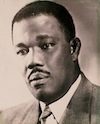Le Flambeau Foundation , Inc., February 2, 2020
 On December 10th 1948 Senator Emile Saint-Lot, the first Haitian Ambassador and a founding member of the United Nations became a signatory of the Universal Declaration of Human Rights along with Chairwoman of the Commission and Former First Lady of the United States Eleanor Roosevelt. Senator and Ambassador Emile Saint-Lot is also a founding spirit and father of Le Flambeau Foundation . Following is an Abstract prepared by Professor James Spickard Ph.D. on this chapter in our shared history.
On December 10th 1948 Senator Emile Saint-Lot, the first Haitian Ambassador and a founding member of the United Nations became a signatory of the Universal Declaration of Human Rights along with Chairwoman of the Commission and Former First Lady of the United States Eleanor Roosevelt. Senator and Ambassador Emile Saint-Lot is also a founding spirit and father of Le Flambeau Foundation . Following is an Abstract prepared by Professor James Spickard Ph.D. on this chapter in our shared history.
Author: Professor James Spickard, Ph.D., University of Redlands, Department of Sociology and Anthropology
Abstract
Presents the history of the 1948 adoption of the Universal Declaration of Human Rights, focusing on the prior status of human rights in international law and the cultural/ideological aspects of the debates surrounding its adoption. This chapter shows both the Western origin of the core human rights concepts and the positive-law nature of the Universal Declaration. it also shows that the cultural issues were present from the very start of the modern human rights era.
Document Type: Essay
Comments from Author: This is a completed chapter, written in 1999, from a long-abandoned book. I encountered conceptual difficulties with the book as a whole, though not with this chapter. I may pick up the ideas again, but who knows in what form? In the meantime, many people, including my students, have found this summary useful.
To read the full abstract click here.
To read the Universal Declaration of Human Rights (in English) (French) (in Kreyol).
